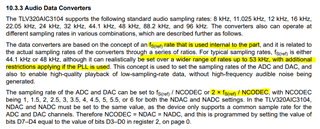I’M USING TLC320AIC3104 AUDIO CODEC but during silence period I have a noisy into headset (a “rusty noise”):
MY I2S DATA are sampling frequency :16KHZ/ 16bits -sample
MY QUESTIONS ARE:
1) CAN I SET REGISTER 7 BIT 5 and BIT 6 to 1 in order to enable the “dual rate”?
2) What does it means “dual rate”? If it is to be referred to oversampling and decimation procedure inside codec, why it isn’t always “enabled”?
3) Is it only for 92Khz or also for all low frequencies? can I use this setting for every lower sampling rate as my case?
-
Ask a related question
What is a related question?A related question is a question created from another question. When the related question is created, it will be automatically linked to the original question.



